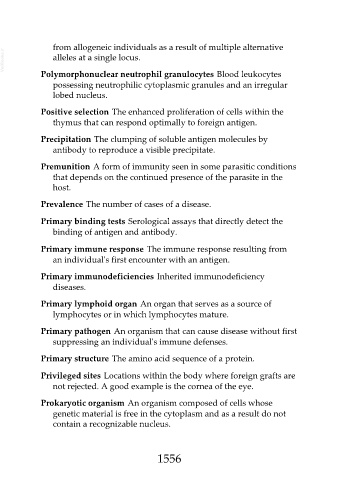Page 1556 - Veterinary Immunology, 10th Edition
P. 1556
from allogeneic individuals as a result of multiple alternative
VetBooks.ir alleles at a single locus.
Polymorphonuclear neutrophil granulocytes Blood leukocytes
possessing neutrophilic cytoplasmic granules and an irregular
lobed nucleus.
Positive selection The enhanced proliferation of cells within the
thymus that can respond optimally to foreign antigen.
Precipitation The clumping of soluble antigen molecules by
antibody to reproduce a visible precipitate.
Premunition A form of immunity seen in some parasitic conditions
that depends on the continued presence of the parasite in the
host.
Prevalence The number of cases of a disease.
Primary binding tests Serological assays that directly detect the
binding of antigen and antibody.
Primary immune response The immune response resulting from
an individual's first encounter with an antigen.
Primary immunodeficiencies Inherited immunodeficiency
diseases.
Primary lymphoid organ An organ that serves as a source of
lymphocytes or in which lymphocytes mature.
Primary pathogen An organism that can cause disease without first
suppressing an individual's immune defenses.
Primary structure The amino acid sequence of a protein.
Privileged sites Locations within the body where foreign grafts are
not rejected. A good example is the cornea of the eye.
Prokaryotic organism An organism composed of cells whose
genetic material is free in the cytoplasm and as a result do not
contain a recognizable nucleus.
1556

